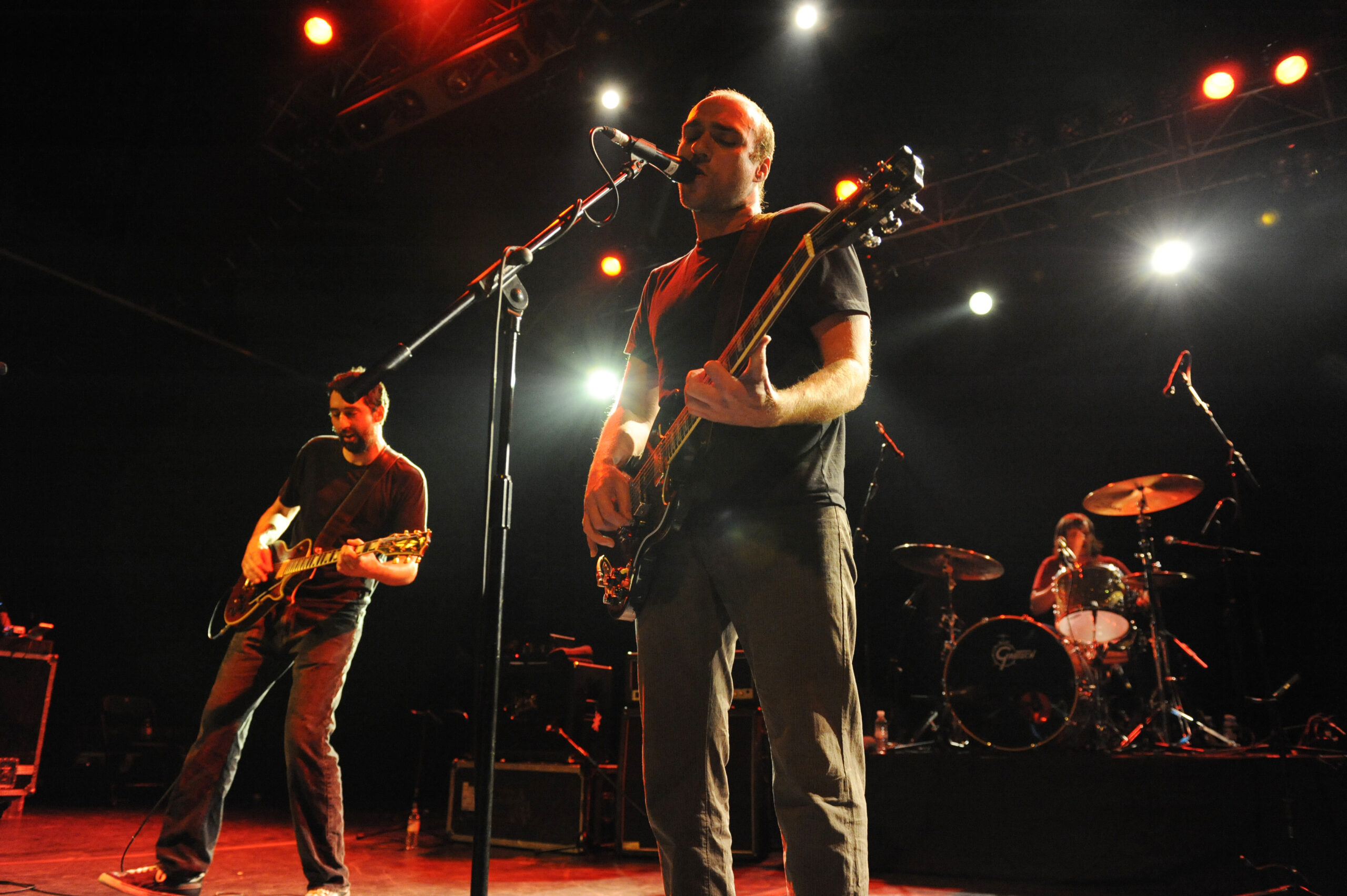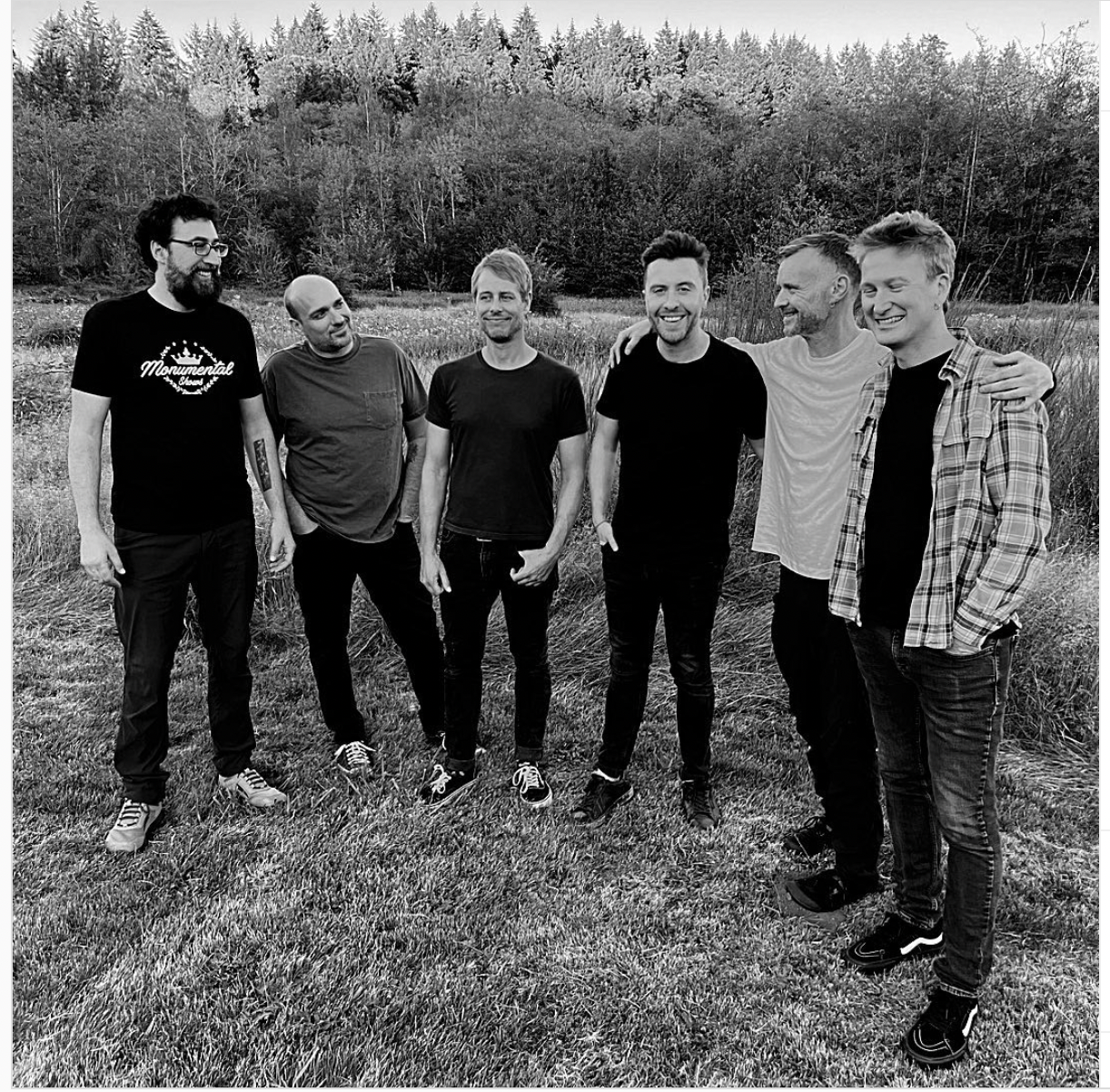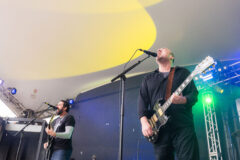Plopped onto 120 acres less than a mile from Walt Disney World in Orlando, Fla., Disney Springs is, according to its creators, “a themed retail, dining and entertainment center inspired by Florida’s charming waterfront towns.” This “sprawling promenade” divided into “four distinct neighborhoods” hosts such lovable establishments as Maria & Enzo’s Ristorante (“savor authentic Italian cuisine at this stunning trattoria,” its Web site invites) and multi-level paeans to corporate behemoths such as Coca-Cola and M&Ms.
At a time when no aspect of American life seems, well, real, this is where SPIN meets Sunny Day Real Estate guitarist Dan Hoerner for a rare interview on an 89-degree afternoon in late September, two weeks into the pioneering Seattle rock band’s first tour in 12 years. Indeed, while they created hugely influential, genre-defining and emotionally resonant music such as 1994’s Diary and 1995’s colloquially titled The Pink Album, Sunny Day Real Estate’s members have often incongruously been their own worst enemies, with a variety of interpersonal dramas resulting in three breakups and reunions and at least one aborted album throughout their on-and-off, three-decade existence.
Chronicling the details would take an entirely separate article, but in summary: Sunny Day formed amid the grunge-driven alternative rock explosion of the early 1990s, signed to Sub Pop after playing just a handful of shows, essentially (and inadvertently) invented modern emo with Diary and decided to break up before recording The Pink Album. Frontman Jeremy Enigk had a religious epiphany and made an orchestral solo album that sounded unlike anything that Sunny Day previously recorded. With their main band defunct, bassist Nate Mendel and drummer William Goldsmith joined Dave Grohl’s Foo Fighters in time for their first tour in spring 1995, but Goldsmith left the band within two years amid well-documented tensions with Grohl. Mendel remained with the Foos and was replaced by a series of bassists when Sunny Day reformed to record 1998’s How It Feels To Be Something On and 2000’s The Rising Tide, before the band broke up again a year later.

Mendel didn’t play with his old bandmates again until a 2009 reunion tour, but he’s not participating this time around after a series of statements made by Goldsmith, including a 2018 video implying that Grohl was somehow to blame for Sunny Day not being able to finish a planned fifth album recorded at the Foos’ Studio 606 more than a decade ago. Mendel said at the time that there was no truth to the claim, and relations between him and Goldsmith have been strained ever since. “A lot of those things were untrue and hurtful to Dave and Nate. I hope one day we’re sitting and talking about how we fixed it with the Foo Fighters, and that they accepted our apology,” Hoerner says. “I also hope and pray one day that I get to play music with Nate again, but we’re going to have to earn it, and it’s not going to be easy.”
Yet despite it all, the 2022 edition of Sunny Day Real Estate has begun this new chapter in an improbably good place. They’re middle-aged statesmen of a genre now celebrated with massive festivals such as Chicago’s Riot Fest and Las Vegas’ When We Were Young, and are capable of selling 1,500 tickets on a weeknight at a theme park-adjacent venue like Orlando’s House of Blues. “It makes me so happy to see how our legacy has aged nicely,” says Hoerner, who was particularly chuffed to see members of Sleater-Kinney, My Chemical Romance, and Circa Survive watching Sunny Day from side stage at Riot Fest. “I also love to see young people out there. There were so many of them in the crowd at Riot Fest, and they were singing every word. How? We haven’t even played a show in 12 years. It’s mind-blowing.”
This trend continued once Sunny Day took the stage in Orlando, with tattooed, pink-and-blue haired, gender-non-specific 20-somethings who weren’t even born when Diary was released screaming the lyrics at ear-piercing volume, some even wiping away tears. Enigk had lost his voice four days earlier after a show in Detroit, forcing the band to postpone and reschedule two dates, but he was in fine form at the House of Blues. Hoerner was in awe of Enigk’s ability to “deliver a controlled performance when his voice was so tender because so much of Sunny Day is about absolutely losing your fucking mind.” “It’s so cool to see you guys so happy and smiling,” Enigk said from the stage, his yearning, soul-penetrating voice only slightly deepened over time. “It’s heartwarming.”
Augmented by new bassist Chris Jordan and guitarist/vocalist Jason Narducy (who is alternating dates with previous Sunny Day touring musician Greg Suran), the band tore through favorites like “J’Nuh,” “Seven” and “In Circles” while recasting songs such as “The Riding Tide” with new arrangements. Whereas the 2009 tour focused almost exclusively on the first two albums, this run is lifting equally from the full Sunny Day discography, plus the knotty, head-nodding “Lipton Witch,” which Hoerner describes as “undeniably the best song” from and the only one to be released out of the Studio 606 sessions (on a 2014 split single with Circa Survive). Goldsmith came down to the barricade after the set to chat with and sign autographs for fans, most of whom leaned in close to tell him of Sunny Day’s impact on their lives. Upstairs, the merch stand did robust business with folks like a tattooed 40-something dad on crutches, who’d driven four hours to the show with his three young daughters.
“Everything we’re playing is our vision of as big and as wonderful and as colorful as we can make it,” Hoerner says, adding that Sunny Day has worked up its first-ever cover (by an all-time great ‘80s college rock band) and hopes to debut it at some point on the run. The group has also drafted noted underground music photographer Sunny Singh to film its nearly sold-out Oct. 1 show at Philadelphia’s 2,500-capacity Fillmore. “We found ways to open up every song and add expansive elements to them. At the end of this tour, we want to record everything we played in the way that we’re playing it now, maybe at [the Hoerner-owned Spokane, Wash., venue] The Big Dipper when it’s empty, then take it to a studio to dig in deep, mess with it and make it what we want. It’s going to be a whole new album.”
Hoerner admits that purported unreleased fifth album instrumentals floating around on YouTube are legitimate and that the band worked on 12 or 13 songs during the sessions but felt they simply “didn’t sound like Sunny Day. It sounded like a straight-ahead rock record, but not even good. Just, like, boring and bland. I’m so grateful to the studio and the generosity of Dave Grohl and Nate, and I hate to diss our work because we did work hard on it. We looked at those and unanimously were like, we missed. We missed the mark. It’s hard because you put in so much and time and effort, and a song becomes a living part of you. We had to bury these songs and move on.”
There is one potential new song, however: an eight-minute-plus unfinished piece of music from a brief period in 1997 when Mendel was considering rejoining Sunny Day during work on what became How It Feels To Be Something On. “It’s like peak Sunny Day, but also very forward-looking,” Hoerner says. “The bass lines Nate created for it are off the charts — they’re like John Entwistle meets Mozart. We’ve been working on it for a while. It’s beautiful. It’s huge. I’ve been writing lyrics for it, and I think they’re timely. They speak to where Sunny Day is at right now and the path we’ve gone down together. We’ll see how it translates.”
Hoerner says he’s continually amazed that Sunny Day Real Estate remains meaningful to new generations of listeners, even if they don’t fully understand the chronology and different sub-variants of ‘90s emo. “My daughter is 15 and she is in a phase of discovering bands,” he tells me. “She came up to me recently and was like, it sounds like you guys copied this band called Jimmy Eat World. I had to explain, well, they’re great and maybe we were a little influenced by them, but most of our stuff came before. We always wanted to try and make something timeless. We were very aware of creating something that didn’t sound exactly like anybody else. Now, of course, it sounds like everyone else [laughs].”
With tour dates booked this year through a Dec. 17-18 hometown finale at Seattle’s Moore Theatre, Hoerner admits it’s “impossible for us not to look into the future. This is the best tour we’ve ever put together, by far: incredible rooms, incredible crowds, incredible guarantees. Everything is bigger and better than we’ve ever done it before.”
Looking forward, the group hopes to eventually visit markets it didn’t hit on this tour, including Canada, the U.K., Europe and South America. “I’d love to go anywhere that people want to hear Sunny Day,” Hoerner says. “I’m always the eternal optimist and Sunny Day Real Estate’s biggest fan, but I’d be very surprised if this doesn’t lead to more things.”





